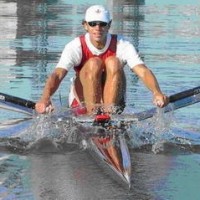Boat Balance

Did you know that: Optimal blade work and the boat roll during the drive depend on two factors: boat rigging (blade pitch and gate height) and the rower’s technique. Combinations of these factors could produce opposite effects.
- If the blade pitch is too low, it creates a vertical downward blade force, which tends to bury the blade deeper in the water. If the rower tries to keep the blade at an optimal depth, they apply the handle force slightly downwards. Summed with the vertical blade force, this results in a downwards gate force, which “tips” this side down.
- Similar mechanics in the opposite direction would work with too high a pitch: the blade reaction would push upwards, the rower has to pull the handle also upwards, which creates an upwards gate force, lifts this side up and “tips” the opposite side.
- If the pitch is the same on both sides and rowers apply forces synchronously, the vertical forces and the boat would be balanced. However, uneven forces would “tip” the boat on the weaker side at high pitch and on the stronger side at low pitch.
- Rowers may intentionally use a controlled boat roll during the drive, e.g., to overcome asymmetry in sculling. Usually, this does not decrease rowing efficiency and speed.
James Lee from Vesta RC, London, and a former Cambridge lightweight rower, is asking a question about balance in a pair: “For example, if the stroke side lost connection, extracted the blade, and finished the stroke earlier than the bow side, would the boat likely tip to the stroke side? … A number of my colleagues believe the opposite would happen - that the bow side blades, still held in the water, would 'anchor' that side down, causing the boat to tip to the bow side. Are you able to bring any clarity to the matter?”
To answer James's question, we compared two pairs with various specifics of the balance. In Pair A, the bow rower dropped force earlier than the stroke with a slightly shallower blade before the finish. Coincidentally, the boat roll was positive with the port side up (3) - the boat “tipped” to this bow side, which confirms James's idea.
As the balance during the drive is well understood and controlled (unless a rower catches a “crab” or loses the handle), the balance during recovery is still quite a controversial issue and usually receives more attention. Many spectacular drills have been invented to improve rowers’ skills to balance the boat acrobatically. Though these drills could help beginners and be quite entertaining for club rowers, they are completely useless for competitive athletes from biomechanical and practical points of view. Moreover, acrobatic drills could create bad habits, be harmful to rowing efficiency and speed, and may cause severe injuries. Quite often, these drills lead to technical mistakes when rowers try to maintain balance during recovery by changing their posture, e.g., “playing” with their knees or leaning with the trunk from side to side. This prevents maintaining a racing stroke rate and relaxing muscles during recovery, making strong, powerful rowers uncompetitive in small boats. Repeatedly skewed knees and spine lead to injuries.
In fact, there are only three factors affecting boat balance during recovery:
- Symmetrical, synchronous, and clean blade extraction from the water at the finish sets the boat level and plays a key role in good boat balance during recovery.
- As long as the oars rotate around the pins with some angular velocity, a significant stabilizing gyro effect is applied to the boat, similar to rotating wheels in cycling.
- The boat would be perfectly stable if the plane of oar rotation does not change during recovery, i.e., rowers symmetrically move the handle on a straight horizontal line.
The most important point is that stable boat balance during recovery allows rowers to relax their muscles, promoting blood flow, oxygen delivery, and enabling high power production during the drive, which is essential for achieving fast rowing speed.
This is a short version of the Newsletter. To access the full text, please subscribe to BioRow membership here: https://biorow.com/membership/
©2024 Dr. Valery Kleshnev



